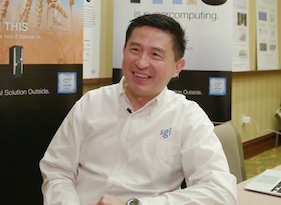In this special guest feature, Dr. Eng Lim Goh from HPE shares the endless possibilities of supercomputing and AI, and the challenges that stand in the way.

Dr. Eng Lim Goh, VP & CTO, HPE
My head is turned to the stars quite often these days.
The main reason, of course, is that we’re now seven months into the year-long mission of HPE’s Spaceborne supercomputer on the International Space Station (ISS). The first high performance commercial off-the-shelf (COTS) computer system ever sent into space, the Spaceborne mission is to see if an onboard supercomputer can support astronauts on a lengthy journey to Mars someday.
So far, so good. The system – with three concentric rings of intelligence built into it – is designed to self-govern. It will shut off if it senses it might break. (Something we all could learn!). It does so with the intent of remaining workable for the astronauts throughout the journey.
In this video from SC17 in Denver, Dr. Eng Lim Goh describes the spaceborne supercomputer that HPE built for NASA.
But in general, my dreaminess is related to the growing ability of supercomputing, and artificial intelligence (AI), to analyze – and one day fully answer – some of mankind’s most profound questions.
Consider what it’s doing for medicine. The German Center for Neurodegenerative Diseases (DZNE) is using our memory-driven computing architecture to quickly and accurately process massive amounts and diverse types of data. Generated by genomics, brain imaging, clinical trials and other research into Alzheimer’s disease, the vast data is too much for traditional computing methods; they are simply too slow. Our system’s single, huge pool of addressable memory is easing bottlenecks, and opening the door to a cure.
We’re also partnering with other research and clinical organizations seeking to advance discovery in neuroscience. Imagine the data we can capture, and analyze when working with the human brain which has 100 billion neurons and 100 trillion synapses!
Across these fields, and countless others, a common thread can be seen: The desire to discover or predict something, and to do so quickly. And that requires a supercomputing system able to adapt to scalable learning, whereby AI enables the computer to teach itself to learn more and more, faster and faster.
Moving to the business arena, scalable learning is making inroads there, too. Can AI systems continue to learn and evolve based on historical data, and then predict – with breakneck speed – the exact time to buy or sell stocks? Of course they can – and with precision that comes close to replicating other predictive models, and usually in a fraction of the time.
Similarly, deep learning and other AI techniques are being used to improve methods to predict and counter fraud. How? By analyzing vast quantities of data, uncovering suspicious patterns and immediately taking steps to prevent, or mitigate, fraudulent activity – sometimes, at the very instant the attempt is taking place. Like the human brain, these algorithms continue to learn and evolve as more raw data is consumed.
Government, too, is benefitting. New supercomputers are helping the U.S. Department of Defense to accelerate the development and acquisition of advanced national security capabilities, while also improving reliability for the Navy’s global weather modeling requirements and supporting the Air Force’s hypersonics research.
The applications for doing good are endless. AI’s future shines brighter. Just like the stars above.



